
The Bottom Line
Introduction, Specifications, and Pricing
Flash has already killed the 15,000-RPM "high performance" disk drive and mature 4-bit per cell "QLC" is taking aim at the 10,000-RPM performance tier.
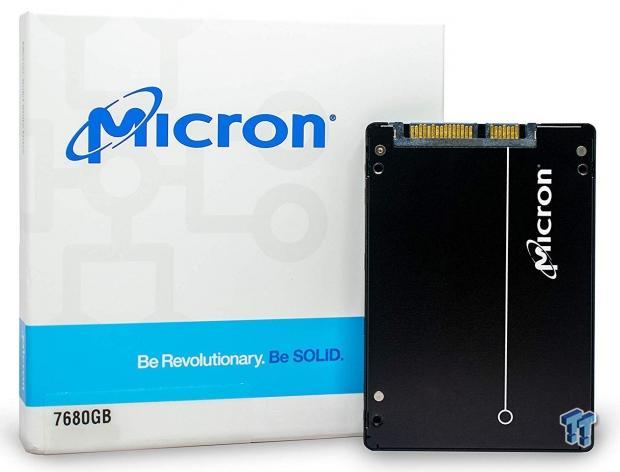
Micron's weapon of choice to disrupt the 10K market is the 5210 Ion 2.5" SATA SSD. The 5210 Ion is the first 4-bit per cell SSD with the full gamut of enterprise features. The series is a direct swap to upgrade existing servers running spinning disks. The upgrade improves performance, power consumption, reliability and capacity. These are the same talking points for flash we've heard through the years. The difference now is even lower cost per gigabyte and improvements in density.
The 5210 Ion isn't just an upgrade model for existing servers. Modern workloads such as machine learning have increase data set sizes without increasing the number of writes to the disk. In years past, we saw a four reads to one write ratio as normal in the datacenter but the ratio has significantly changed in recent years. Micron tells us key customers see 5,000 reads to one write with many modern workloads. These workloads ushered in the QLC era.
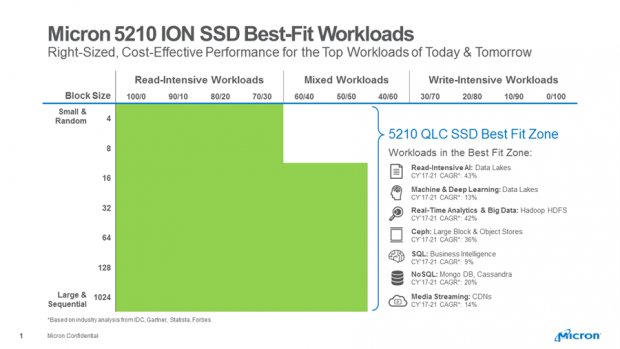
When companies announced QLC technology, several datacenter customers paraded at Flash Memory Summit demanding low-cost flash for WORM or Write Once Read Many workloads. When finally available for testing, it became clear that QLC's endurance was much stronger than first estimated. WORM workloads were just the start thanks to powerful error correction technology perfected over the last several years with 3-bit per cell technology.
Specifications
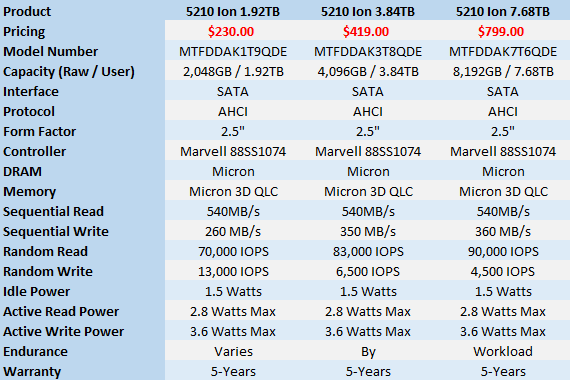
Micron released the 5210 Ion series in three capacities, 1.92TB, 3.84TB and 7.68TB. The company lists single drive performance at 540 MB/s sequential read and between 260 MB/s to 360 MB/s sequential write speeds depending on the model (and uses steady-state results).
The 5210 Ion's random performance peaks at 90,000 read IOPS for the 7.68TB drive and drops off from there to 80,000 IOPS (3.84TB) and 70,000 IOPS (1.92TB). Steady-state random write performance peaks at 13,000 IOPS for the 1.92TB model. The 3.84TB model moves the needle to 6,500 IOPS and that drops to 4,500 for the largest capacity, 7.68TB.
Features
- Micron Flex Capacity
- AES 256-bit Encryption
- TCG Enterprise
- Power Loss Protection (in-flight and at-rest)
- Enterprise Data Path Protection (User and Meta Data)
- Hot Plug
- Adaptive Thermal Monitoring
Micron released the 5210 Ion with an impressive enterprise feature set that includes encryption, power-loss protection, variable capacity via software to tune the performance of your workload and the endurance of the drive.
Best-Fit Workloads
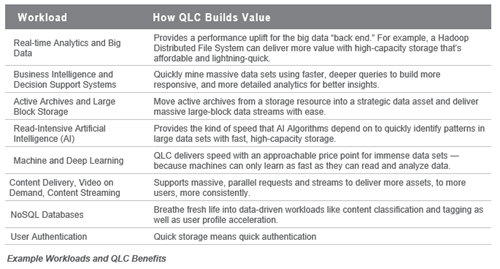
Micron isolated a number of workloads friendly to the 5210 Ion. All the workloads listed feature heavy reads and minimal data writes.
Warranty and Endurance
We usually talk about endurance and warranty coverage with pricing, but the 5210 Ion is not a normal SSD. The series carries a traditional 5-year warranty against defects. The endurance is where this product differs from any other.
Most enterprise and consumer SSDs carry a fixed endurance usually promoted in either drive writes per day (enterprise) or total bytes written (consumer). The 5210 Ion gives users a better look at what to expect by the workload.
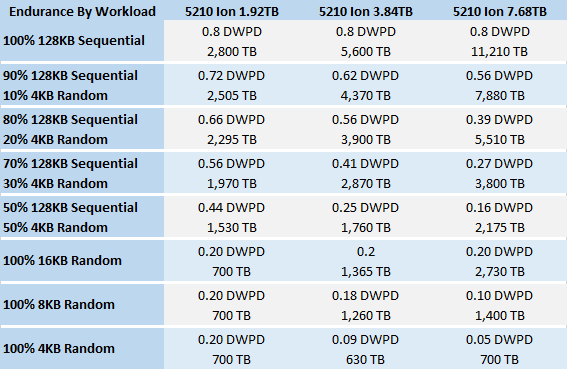
We've known for nearly a decade now that small block size data writes wear flash faster than large data blocks. We usually associate small block data as random data due to the way file systems store information.
Starting with 100% sequential writes, the 5210 Ion series has a simple 0.8 drive writes per day (DWPD). Mixing random data changes the DWPD endurance rating and all three capacities receive a different value.
Pricing
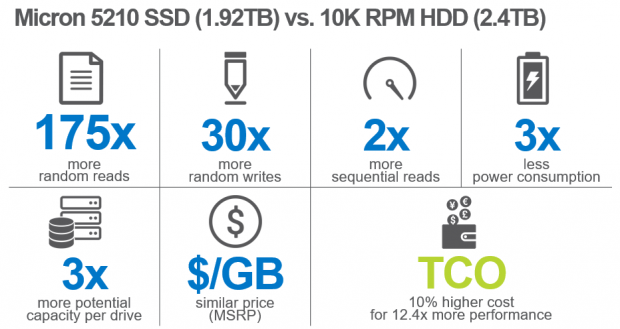
The 7.68TB 5210 Ion is the lowest cost SSD in this capacity range. We found the drive at several outlets for right around $799. Bulk pricing from Micron may be less for some customers. The mid-capacity drive with 3.84TB sells online for $419 and the 1.92TB model for $230. We used Amazon for pricing details but CDW and even Newegg stock the 5210 Ion series.
In the chart above, we see Micron's take on pricing vs. a generic 2.4TB 10,000-RPM HDD. In the datacenter pricing goes well beyond the initial purchase cost and you can break pricing down a number of ways to reach a total cost of ownership.
Software
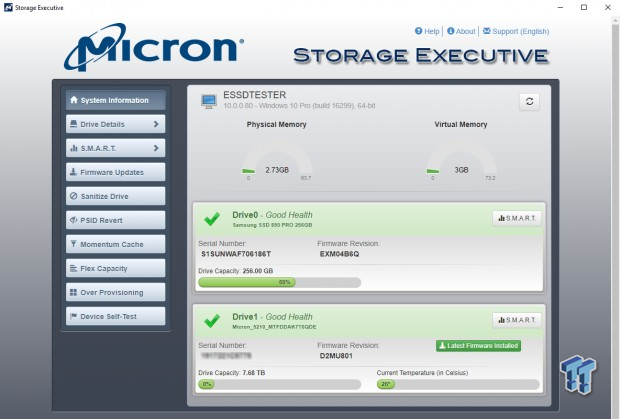
The 5210 Ion works with Micron's Storage Executive SSD Management Tool. We use the tool in Windows to monitor the drive, but it has other useful features.
A Closer Look
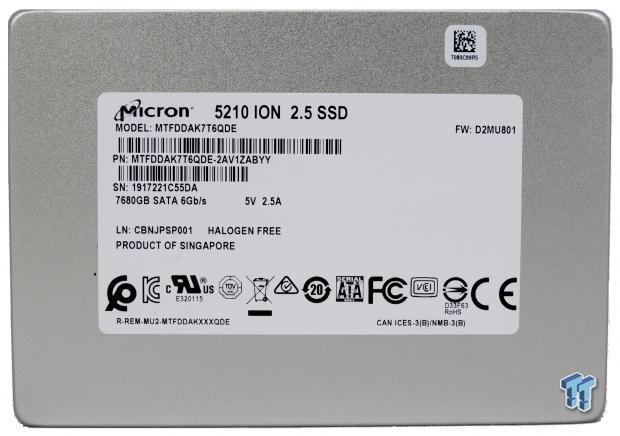

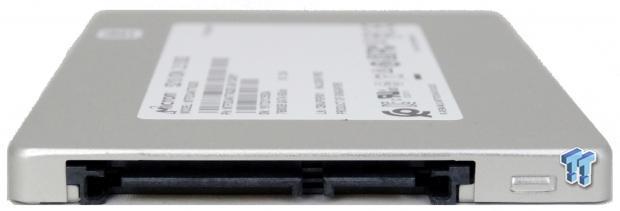
The 5210 Ion series looks like most Micron and Crucial SATA SSDs shipping today. The series uses the thin metal silver case held together with tabs on each side. This series is all about delivering the best available value, so don't expect extras in the package.

| Today | 7 days ago | 30 days ago | ||
|---|---|---|---|---|
| Loading... | Loading... | |||
|
* Prices last scanned on 12/31/1969 at 6:00 pm CST - prices may not be accurate, click links above for the latest price. We may earn an affiliate commission from any sales.
|
||||
Synthetic Performance Testing
Testing Notes
We used a Supermicro dual Xeon storage server for testing today. The server is very similar if not identical to what a company would already have operating with 10,000 RPM drives today. For the server, we updated the slower Xeons that shipped with the system to E5 2690 8-core processors. We also swapped the slower RAID controller with an Areca ARC-1883 series.
We tested five sets of drives including two Micron 5210 Ion models, 1.92TB and 7.68TB. The comparison products all come from Seagate. We started with the Enterprise Performance 1.2TB, a 10,000-RPM model. Then wanted to add a modern 7,200-RPM series. The Seagate IronWolf Pro 12TB fit the bill. It is our standard drive for testing network-attached storage systems. Finally, we added a Seagate Enterprise Turbo SSHD array to the results to test a higher performance tier HDD.
Sequential Read Performance
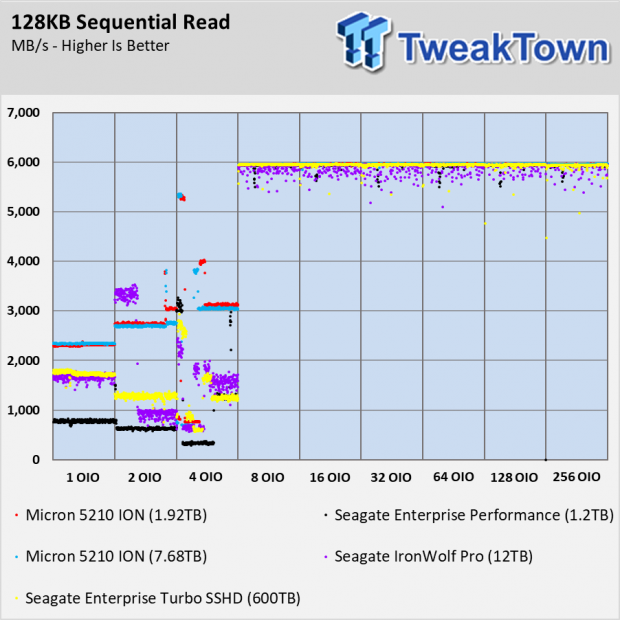
Our test system uses Windows Server 2016 so some of our issues at 2 and 4 OIO carry over just like with the Windows 10 PCs. This is the first time we've experienced the sequential read 2 and 4 OIO performance drop with a RAID controller. The issue stands out more with the three HDD arrays but it affects all arrays in the sequential read test. We will look closer at the sequential performance in the mixed workload charts later in this review.
Sequential Write Performance
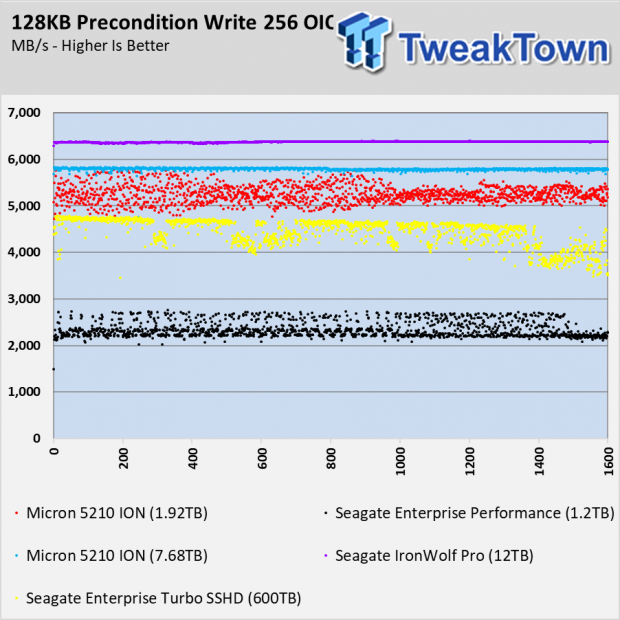
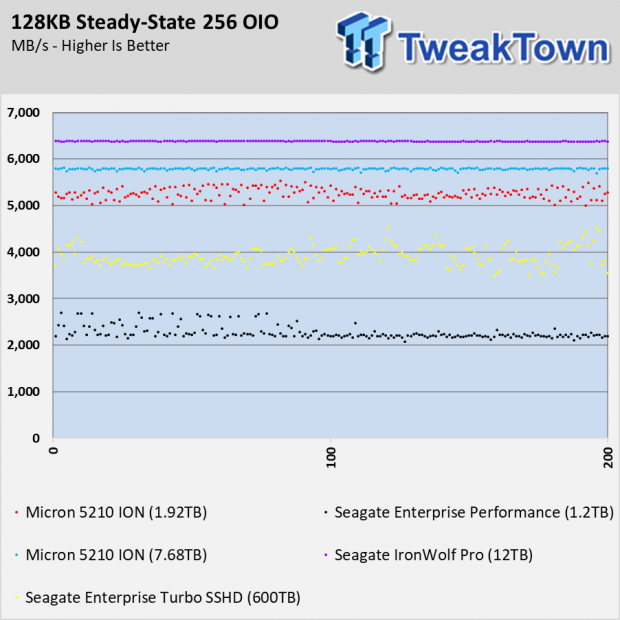
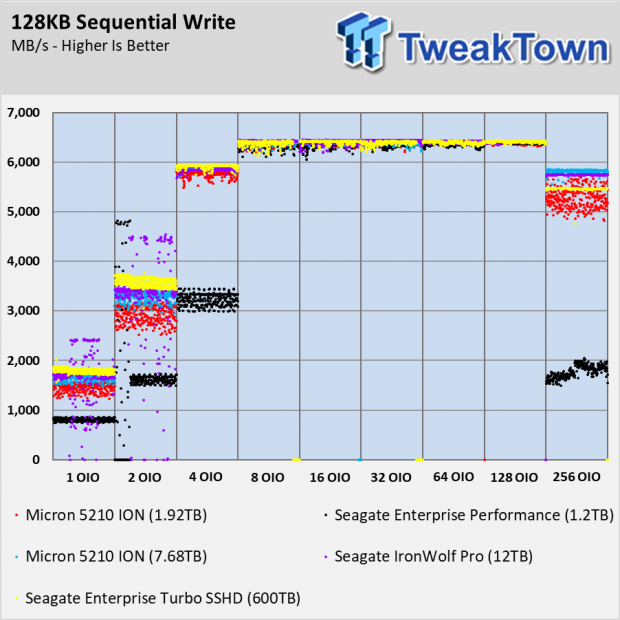
The 128KB sequential write preconditioning and steady state tests show strong performance consistency in an array behind a controller. The performance tests in the third chart show both 5210 Ion arrays outperforming the 10K Seagate array and on pace with the 15K SSHD.
Sequential Mixed Workload Performance
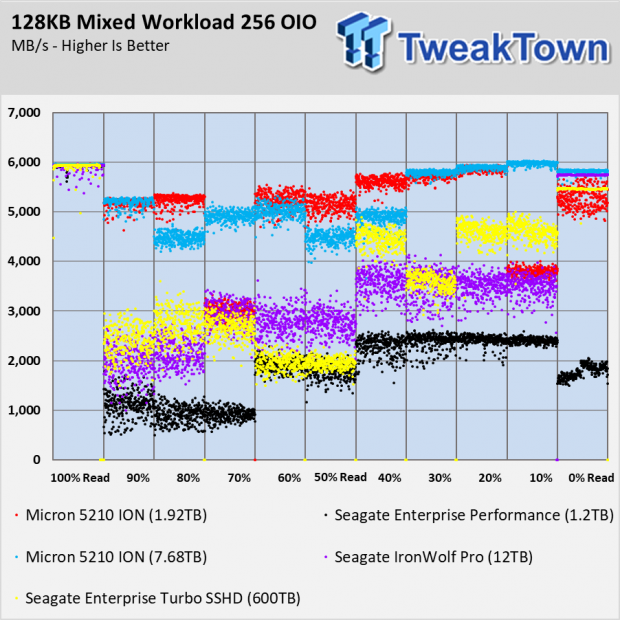
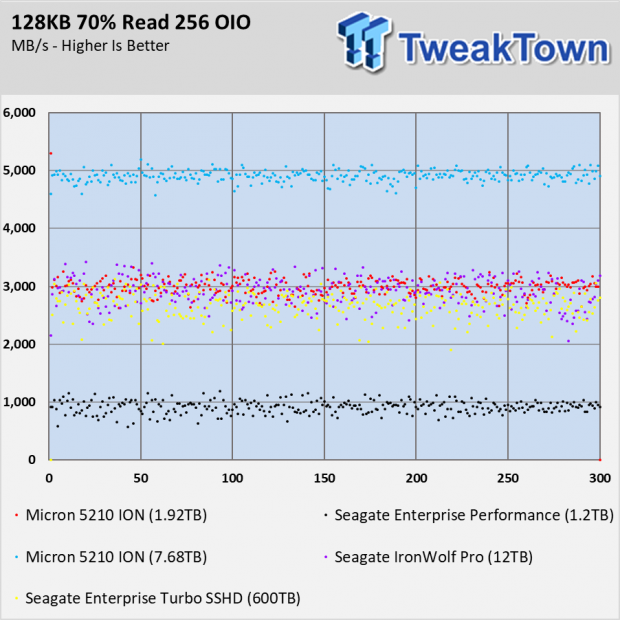
One of the largest improvements in the sequential workloads over the HDD arrays comes in the mixed test with the arrays performing both reads and writes. The 5210 Ion arrays can easily double the performance of mechanical drives in some of the mixes and it doesn't even take a large amount of data writes to see a massive performance improvement. For example, the Ion arrays with 90% reads easily double the average of the three disk drive arrays.
Random Read Performance
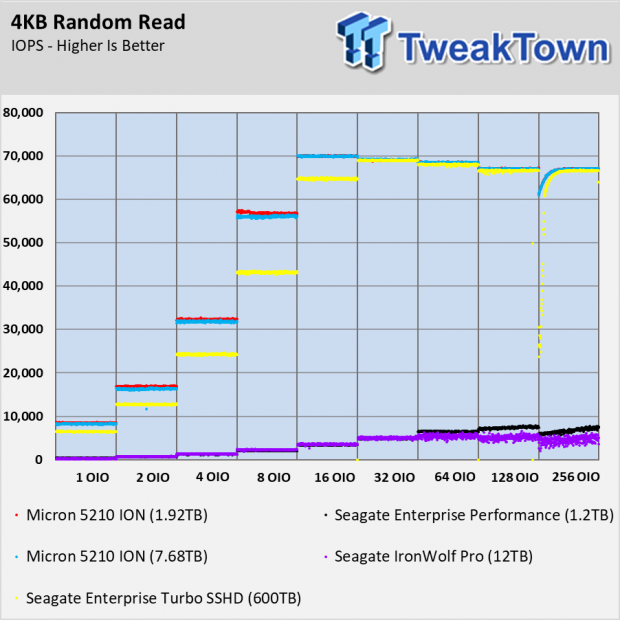
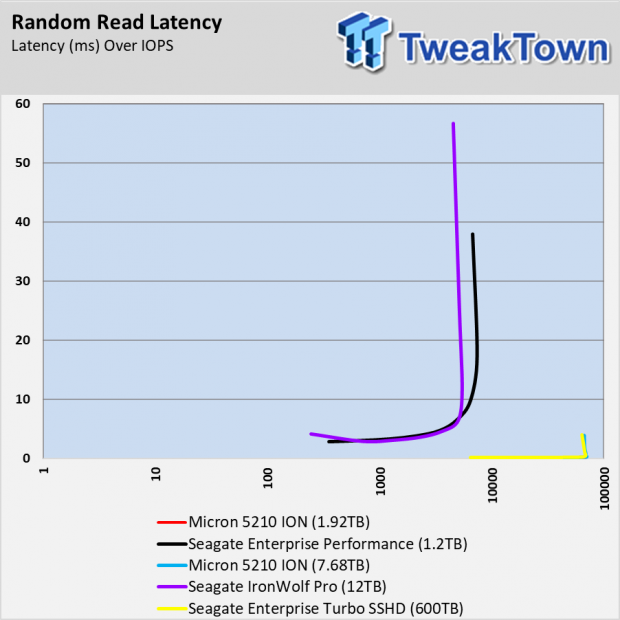
It's been several years since we've put a SSD in the same performance charts with hard disk drives. The results are the same even in powerful multi drive arrays. Flash has the benefit of no moving parts to retrieve data. Random performance is significantly up as while the latency is vastly down. This is how the 5210 Ion runs circles around mechanical drives in complex tasks like machine learning and advanced AI.
Random Write Performance
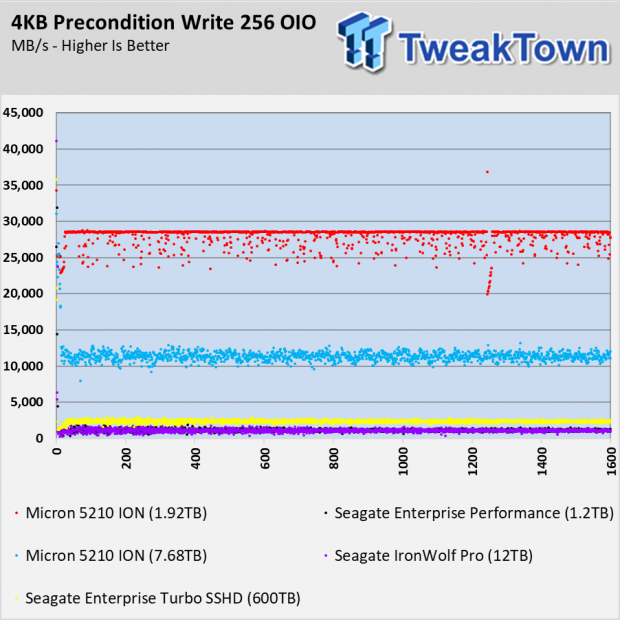
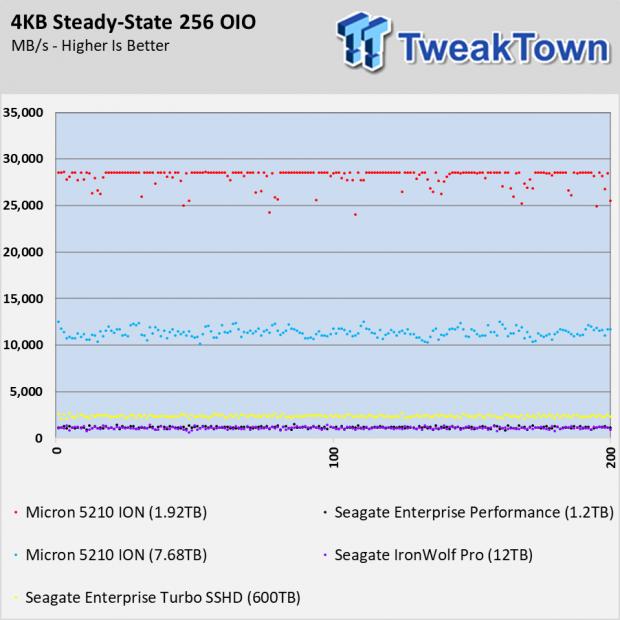
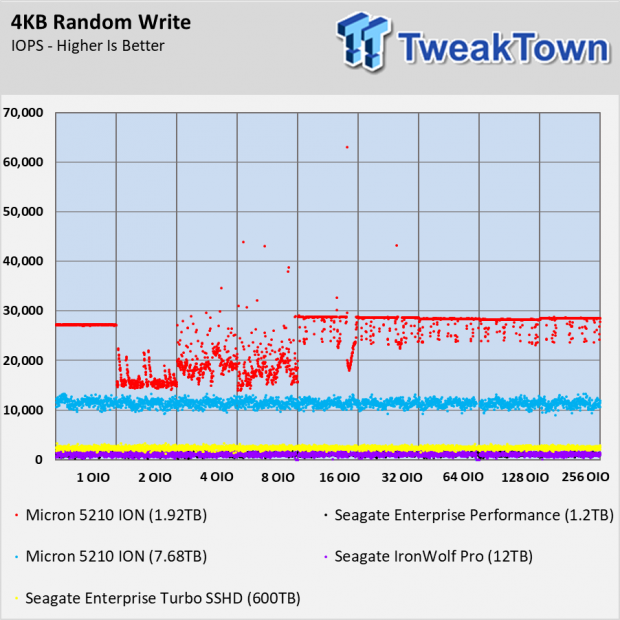
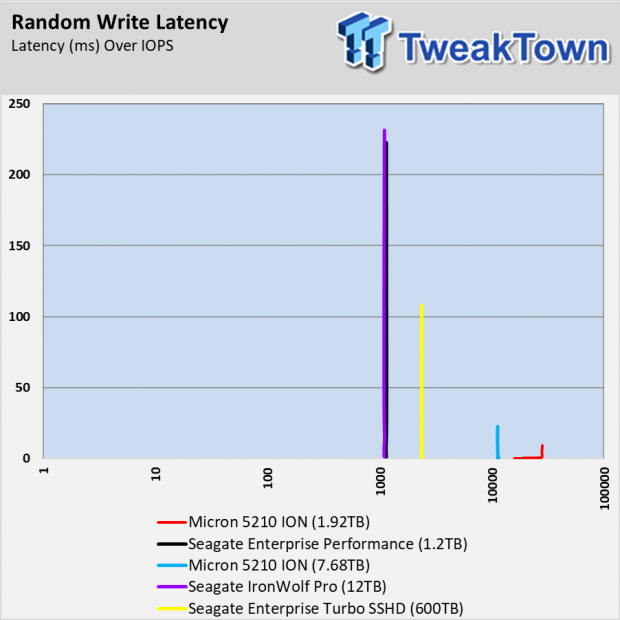
The 5210 Ion specifications show the 1.92TB model has the fastest random write performance of the three sizes released. A single 1.92TB delivers 13,000 IOPS and a single 7.68TB delivers 4,500 IOPS. Both deliver superior performance to hard disk drives including the SSHD models.
Random Mixed Workload Performance
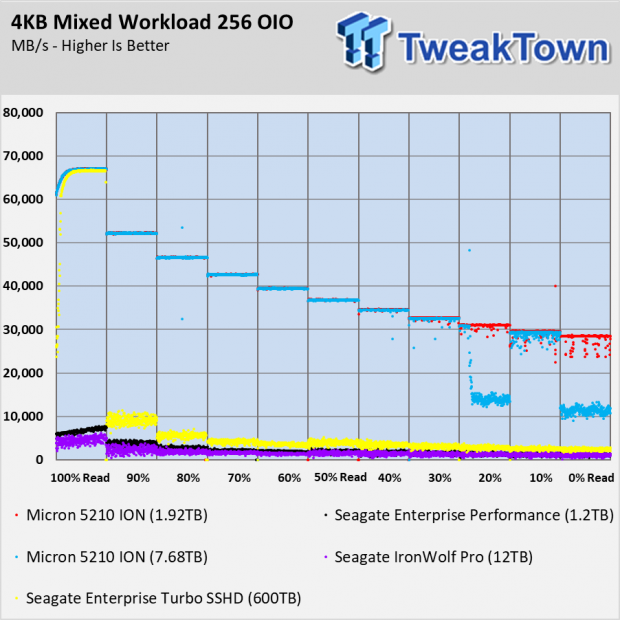
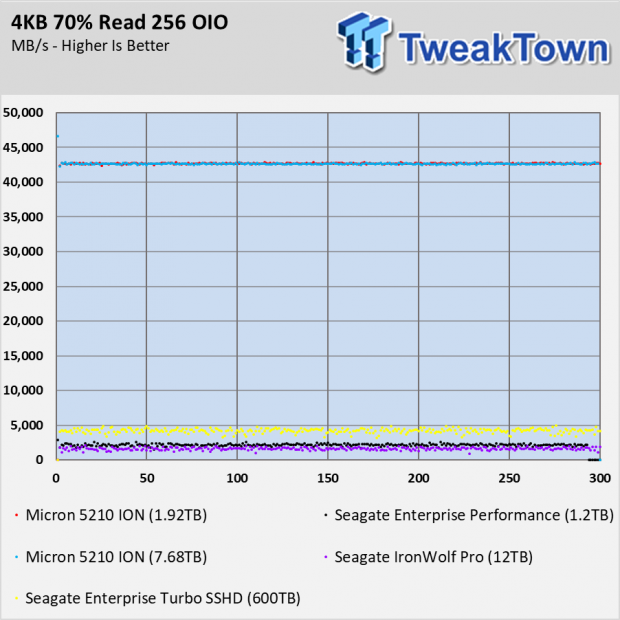
The 1.92TB's random write performance doesn't give that model a clear lead in an array through all mixed random workloads. As we introduce more reads into the mix, the 7.68TB model catches up the smaller array.
It shouldn't be a surprise to see the Micron 5210 arrays outperforming the two HDD arrays through this entire test. The SSHD array managed to keep pace in the 100% read workload but quickly fell to HDD performance levels with the just 10% writes added to the mix.
Workload Performance Testing
Database Workload
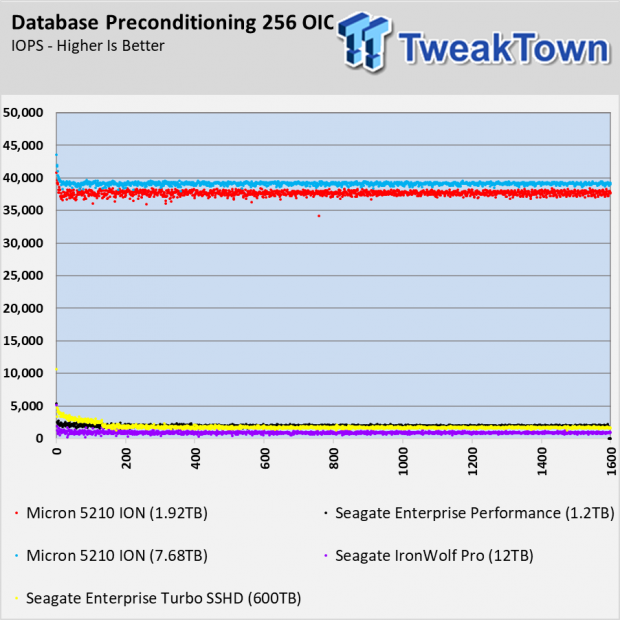
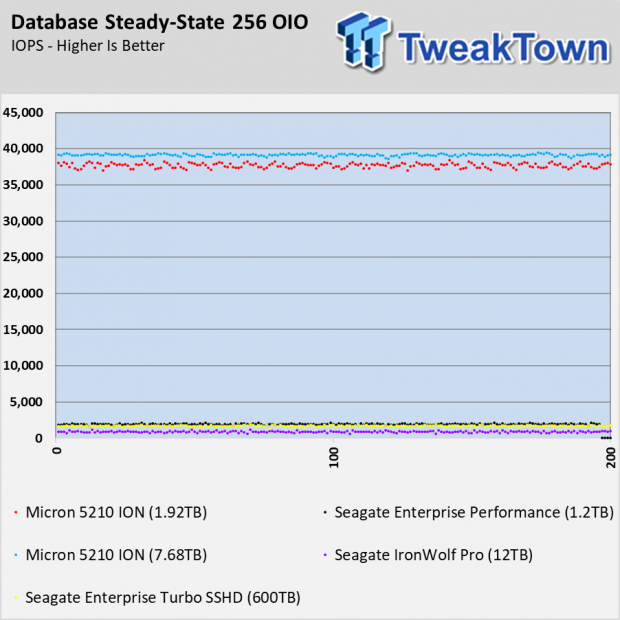
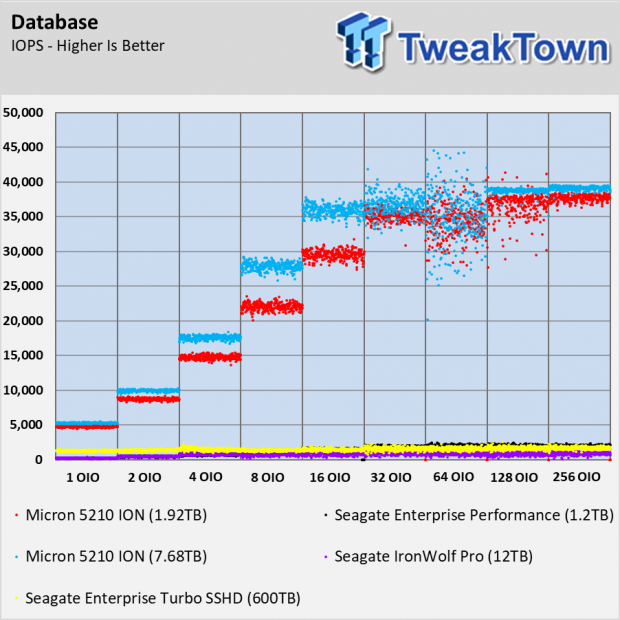
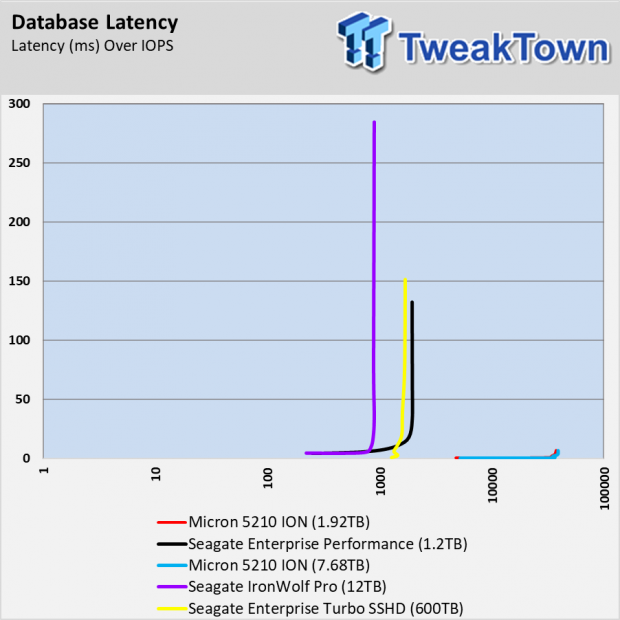
With the synthetic tests out of the way, we can shift to workload performance. The results show a similar divide between the hard disk drive arrays and the Micron 5210 series SSDs. The small block size reads and writes in the database test shows typical SATA SSD performance with the highest performance coming from the heaviest workloads. This is due to the way flash scales performance with queue depth or in this case, outstanding IO (OIO).
OLTP Workload
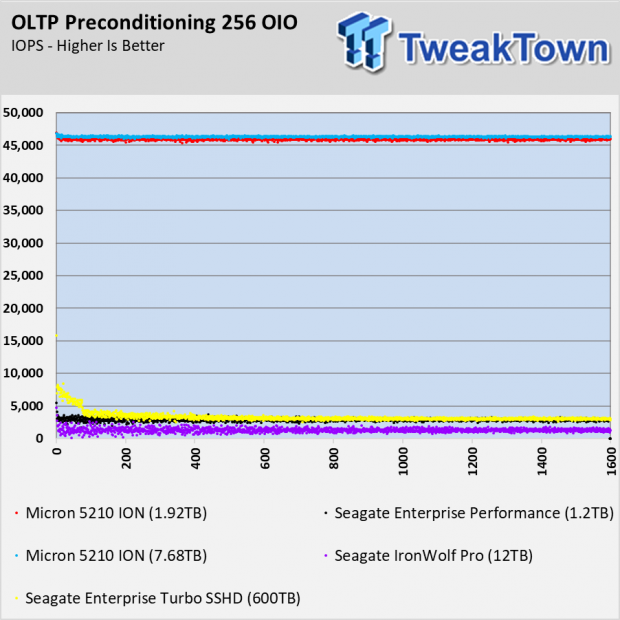
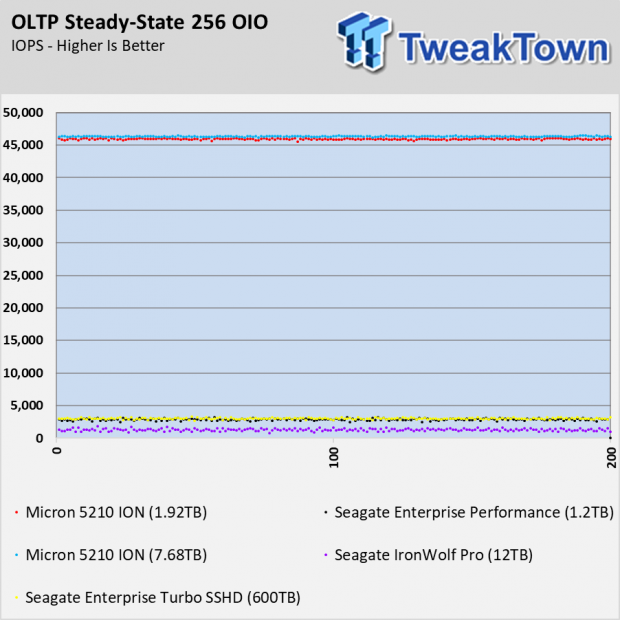
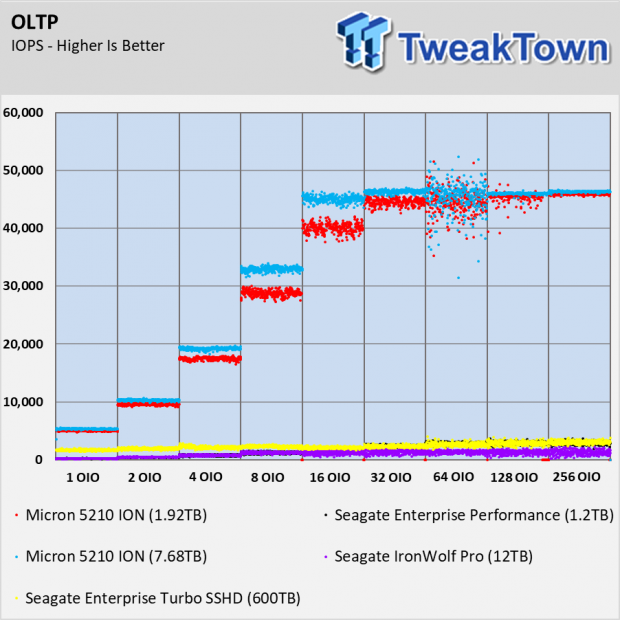
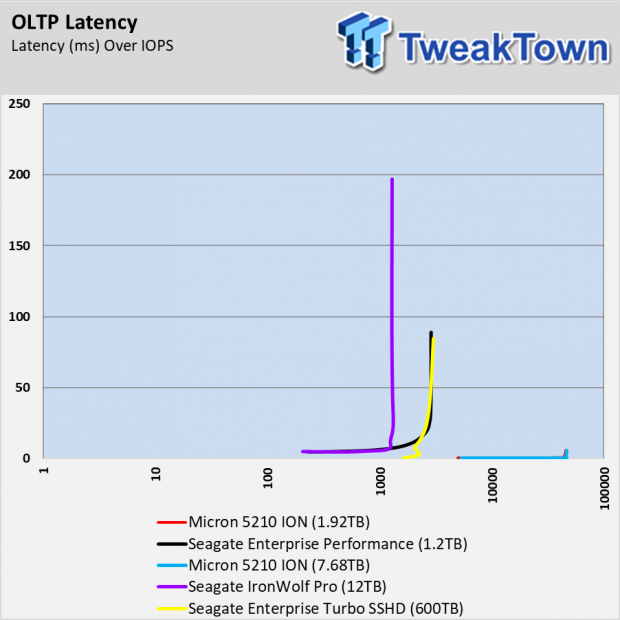
The OLTP test using 8KB size blocks shows strong consistency through most of the test. In the 64 OIO plane in the scaling workload charge, the two drives lose some consistency. We see this issue in several tests at different times but in short bursts.
We can only assume the inconsistent areas are the 5210 Ion SSDs performing background operations.
Email Workload

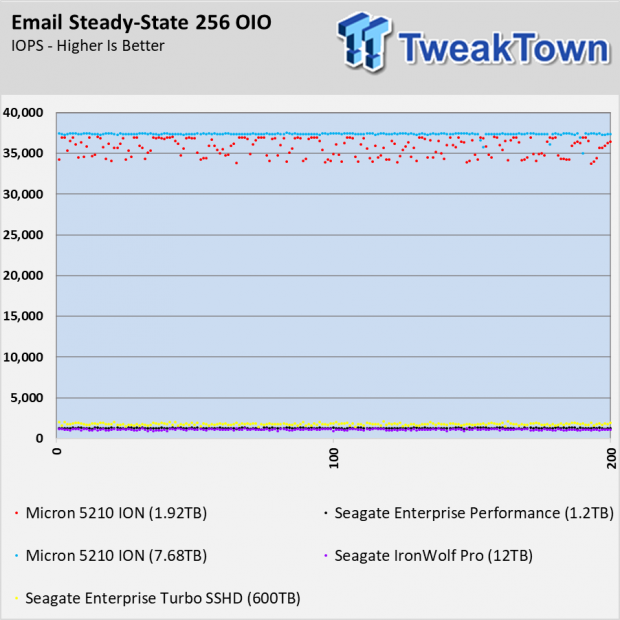
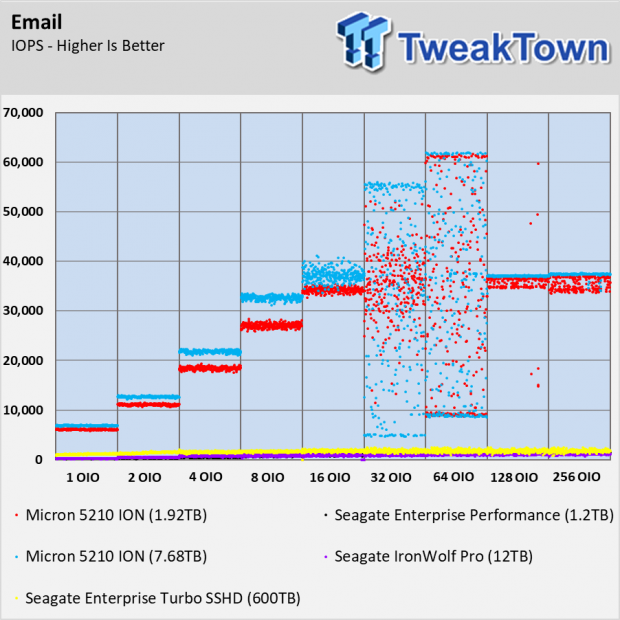
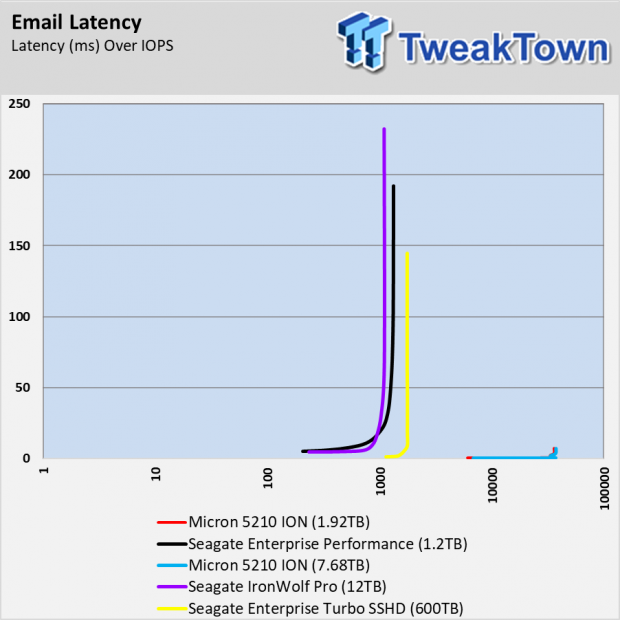
The email workload shows wider deviation in the 32 and 64 OIO scale. If Micron designed this series for heavy workloads like the 9300 series we previously tested, this would worry us. The 5210 Ion will never see heavy, write-focused, workloads like many of the tests we're running today.
Archive Workload
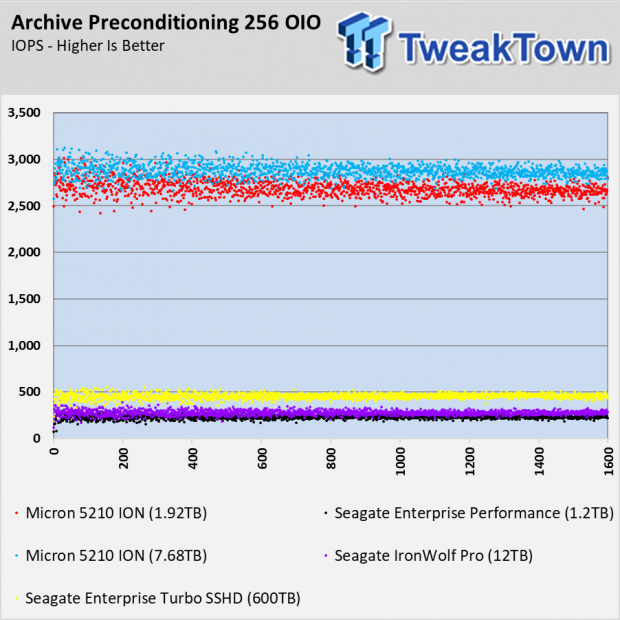
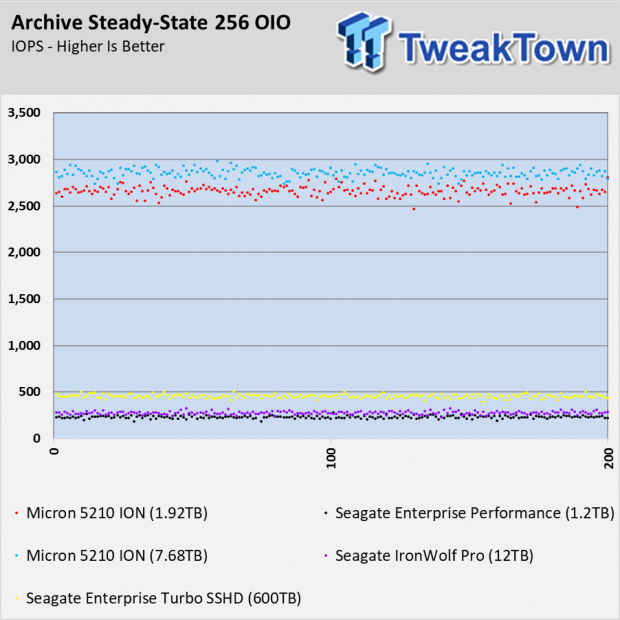
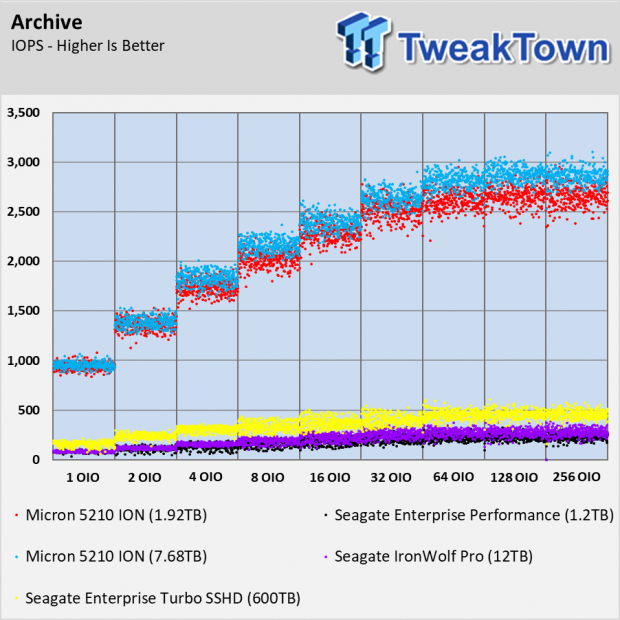
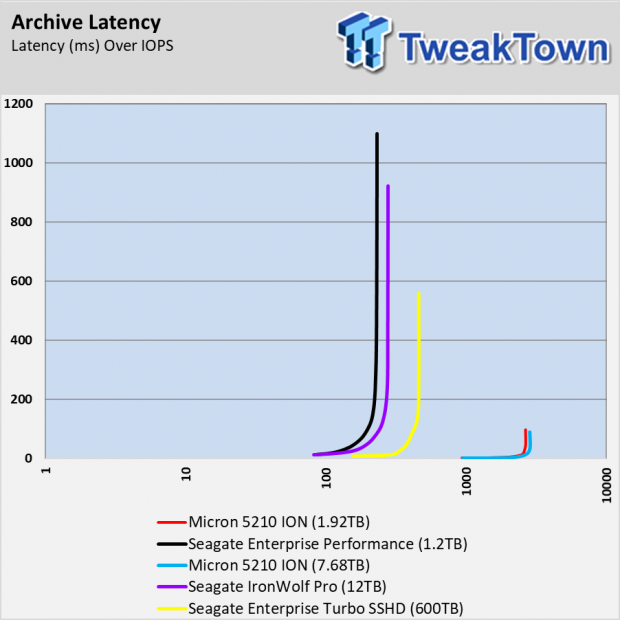
The archive test comes from Dell's Performance Lab and is one of the most stressful tests we run. This is due to the wide range of block sizes and mix of sequential and random reads and writes. The RAID controller helps to tame the test and allows the five arrays to keep the deviation to a minimum at the server level.
Final Thoughts
The Micron 5210 Ion is a product that defines a segment in the market. We've seen enterprise SSDs in the read intensive category before but none or very few that scale to 7.68TB. The largest capacity 5210 Ion is really in a class of its own right now. Micron has some competition at the 1.92 and 3.84TB capacities if you want to get in the weeds and say there are products that exist alone. Micron's ability to utilize 4-bit per cell memory in a world still dominated by more expensive 3-bit per cell memory brings a serious pricing advantage. This is the 5210 Ion's advantage comes from because no other enterprise SSD dips low enough in cost to become so competitive with datacenter disk drives.
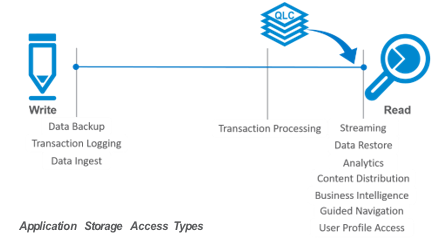
We talked about workloads through the article but didn't look closely at the applications. A number of applications use ideal access patterns for this series. Most of these involve data written to the drive and then read from storage several times. This doesn't mean cold storage per se. The data can be active, but it stays in place.
There are obvious endurance issues with 4-bit per cell flash in some environments and that is why Micron did a good job of explaining drive writes per day. What we didn't see is endurance for hard disk drives. SSDs use the drive writes per day model because reads have such a small impact on SSDs. That is not the case for hard disk drives. HDDs use a drive read write per day or DRWPD endurance rating.
The Seagate IronWolf Pro we used for testing today features a 300 TB per year endurance or 1,500 TB over the 5-year life of the drive. This rating encompasses both reads and writes. The 7.68TB 5210 Ion delivers 11,210 TB data writes alone before we even account for the data reads.
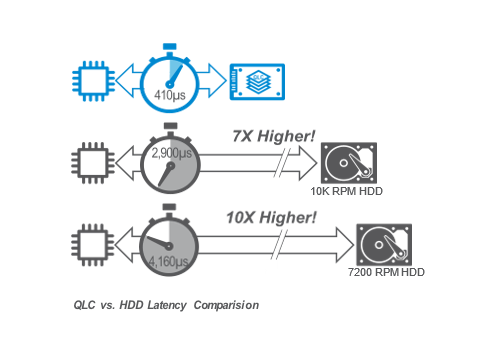
A number of factors weigh in on total cost of ownership for the Micron 5210 Ion series. Power consumption favors the Ion over disk drives but so does the amount of work you can complete over time.
Flash reduces latency per IO and allows this series to breeze though tasks. Colfax Research demonstrated in a TensorFlow test that the 5210 Ion could shave 13.3 hours off a workload task. This was an 8x time decrease over a similar array with 7,200 RPM HDDs. We are working on building a similar test in the lab now. This should come as a surprise. System administrators have learned over the last decade that flash always trumps mechanical storage in performance. The 5210 Ion difference comes down to the most basic requirement system administrators must account for, the cost.
By leveraging 4-bit per cell memory, Micron managed to push mechanical drive technology one-step closer to the ledge. Flash continues to gain ground on traditional disk drive technology, and this marks another workload where SSDs simple deliver a better value.
